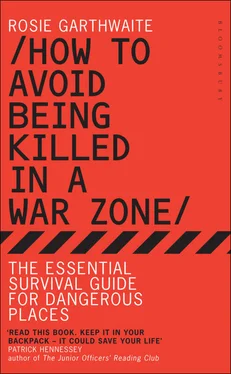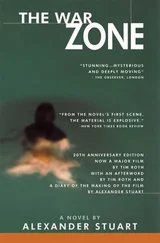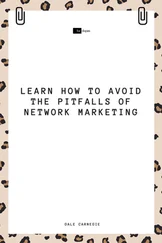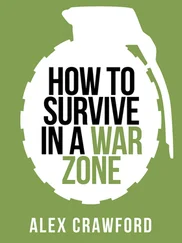Inform others immediately. Warn those around you. Call for help, but keep others away. If you are in a car, use the horn to summon help.
Note the area. What else can you see: mines, tripwires, mine signs? Visually locate the nearest safe area – the last place you knew you were on a safe surface, such as a paved road, well-used path, or concrete or steel structure.
Evaluate your course of action. Be prepared to take control.
Do not move if there is no indication of a safe area, or you can’t reach it without stepping on unknown ground. Wait for help to arrive.
/WHEN NO HELP IS AVAILABLE…
According to the National Technical Standards and Guidelines for mine action in Sudan, ‘It is better to spend two days in a minefield than a lifetime as an amputee.’
However, if there is genuinely no possibility of getting outside help, you might be forced to take action. There could also be exceptional circumstances when faster action is forced upon an individual or group of people, such as when someone is injured and the others must clear a path to reach the victim.
If your footsteps show clearly in snow, sand or wet mud, you can follow them back. However, they must be clear enough for you to know with certainty where you are treading. If you are in a car, climb onto the roof and walk back along the car tracks if they are entirely clear.
Prodding the ground and retracing your stepsis an extremely risky business if not taught properly by certified professionals, so you are strongly advised against attempting it. If you know in advance that you’re heading into regions or countries where mines are considered a threat, it could be worth getting professional instruction and practical exercises in the technique of prodding before you go. At the very least, read the following information first.
Prodding is the traditional technique used by military and civilian landmine clearance agencies alike, and ordinarily used in conjunction with other tools, such as metal detectors. The technique involves using a sharp, pointed, long-bladed instrument, such as a knife, to prod the ground at a shallow angle (no more than 30 degrees) and at short intervals (no more than 20–25 mm) to detect the presence of objects hidden under the surface and clear a safer passage through a dangerous area. The depth to which it will be possible to prod will depend on the ground conditions. Some mines may be located fairly deep beneath the surface and beyond the range of the prodder.
/IF SOMEONE IS INJURED BY A LANDMINE
The time period during which the casualty should be delivered to hospital is sometimes called the ‘golden hour’ because for about 60 minutes the blood vessels and capillaries around the wound site constrict in response to the trauma, restrict the bleeding and naturally compress the damaged tissue. This gives paramedics and any others assisting critical minutes to get the casualty to where transfusions and proper surgical help are available.
While you are waiting for help to arrive, take the following steps:
• Ensure that you are not in danger yourself.
• Apply first aid and stem the bleeding.
• Stabilize the casualty and prepare for transportation.
• Select a safe route to the closest hospital with transfusion and surgery facilities.
• Call or radio ahead to prepare the hospital for the arrival of the casualty.
/IMPROVISED EXPLOSIVE DEVICES
The aftermath of improvised explosive devices (IEDs) – namely, people with devastating injuries and graves at every turn – can be seen in numerous places around the world. They have been around for more than a century and used in all the wars within living memory. Perhaps because of media coverage, or maybe because at one point there were dozens a day, the improvised explosive device seems to be the weapon that defines the war in Iraq. The whole convoy of US vehicles in Iraq has been adapted and re-adapted to make them IED-proof, and still the bomb-makers are inventing new devices. The struggle to beat them has even been immortalized in the multi-award-winning film The Hurt Locker .
The picture that won me a job at Reuters was taken three days after I arrived in Baghdad, when a roadside bomb hit a convoy of armed Humvees 50 metres in front of me. Iraqis jumped into action, pulling wounded, burnt and broken soldiers from the flaming vehicle. On a busy day in relatively quiet Basra I once visited three roadside bombs that went off during one hour, all within half a kilometre of each other.
The journalist Imad Shihab says: ‘I think there is no way IEDS can be avoided by ordinary people, without sophisticated devices like the ones the US Army has. They can be anywhere and any shape. They could be under the pavement, even in the corpses of men and animals. Like what happened to my friend and her mother when kidnappers planted IEDs inside their bodies after they killed them. When people tried to move the dead bodies the triggers went off, killing many more people.’
IEDs are not just roadside bombs, and not just in Iraq. They are found in every war zone – attached to cars, hidden inside pianos and even, as Imad said, inside dead bodies. They can be targeted or random. Sometimes you get a warning and sometimes you don’t. If the locals are not actually the target of the devices, they usually know where they are, but sometimes they won’t be told. IEDs are intended to cause chaos and fear for everyone.
My advice is to avoid being blown up as best you can, and to heed the following tips from Imad:
• Stay away from possible targets – army vehicles and obviously armoured or brand new-looking cars.
• Take routes that possible targets don’t usually use.
• Sometimes locals get news about an IED being planted somewhere for a particular target. They pass the news around the community and people avoid the area. You need to tap into this sort of information whenever possible.
• If an IED goes off, you should hit the ground, facing away from the blast; cross your legs and cover your head with your hands.
I also offer the following advice from an explosives expert in the British Army. He works for a regiment that specializes in disarming IEDs. Due to his position within the forces, he has provided his advice anonymously.
‘IEDs differ from conventional bombs and mines in that they will always be placed by a perpetrator in an area of their choosing as opposed to being in a minefield or former bombing range. This means that it is potentially more difficult to determine where you might stumble upon them. The question you need to ask yourself is, “Who is likely to have placed an IED and why?”
‘An IED can take many forms and will always be designed to blend in with its background so that it is difficult to identify what is or isn’t an IED. For example, is that shopping bag in a crowded supermarket out of place or just someone’s shopping that has inadvertently been forgotten? That is what the perpetrator is hoping you will think, but before paranoia sets in that every bag is an IED, you have to ask the question you asked before: “Who is likely to have placed an IED and why?”
‘Before carrying out an IED attack the perpetrator will study their target and look for a weakness they can exploit, or something they can do that will go unnoticed in normal life. Now look at where you are and what the conflict you are following is trying to achieve: that will give you the best indication if you are in an area where someone might wish to use an IED.
‘If you have been in an area for some time, you will know what normal life is like, so look out for what is not normal. Are children who normally play in the streets missing from view? Is a usually bustling hive of activity oddly quiet? These can be indications that something might be about to happen.
Читать дальше




![Джонатан Димблби - Barbarossa - How Hitler Lost the War [calibre]](/books/385421/dzhonatan-dimblbi-barbarossa-how-hitler-lost-the-w-thumb.webp)







